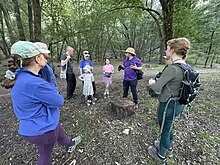|
City Nature Challenge The City Nature Challenge is an annual, global, community science competition to document urban biodiversity. The challenge is a bioblitz that engages residents and visitors to find and document plants, animals, and other organisms living in urban areas.[1][2] The goals are to engage the public in the collection of biodiversity data, with three awards each year for the cities that make the most observations, find the most species, and engage the most people.[1][3][4] Participants primarily use the iNaturalist app and website to document their observations. The observation period is followed by several days of identification and the final announcement of winners.[1][5] Participants need not know how to identify the species; help is provided through iNaturalist's automated species identification feature as well as the community of users on iNaturalist, including professional scientists and expert naturalists.[6] HistoryThe City Nature Challenge was founded by Alison Young and Rebecca Johnson of the California Academy of Sciences and Lila Higgins of the Natural History Museum of Los Angeles County.[7] The first event took place in 2016, in which Los Angeles competed against San Francisco and won in all three categories (most observations, most species, most participants).[8][9] In 2017 the challenge expanded to 16 cities across the United States, with a different city winning in each category.[10] In 2018 it expanded to 68 cities across the world, but US participation still dominated and San Francisco won in all categories.[3][10] The 2019 challenge was more than doubled in scale and took the competition beyond its US roots, with Cape Town, winning two of the three categories.[11][12] In 2020, the organizers removed the competition aspect due to the COVID-19 pandemic, stating, "To ensure the safety and health of all participants, this year’s CNC is no longer a competition. Instead, we want to embrace the collaborative aspect of sharing observations online with a digital community, and celebrate the healing power of nature as people document their local biodiversity to the best of their ability." This change remained in effect for following years.[13] ResultsReference:[14] References
External linksWikimedia Commons has media related to City Nature Challenge. |
Portal di Ensiklopedia Dunia